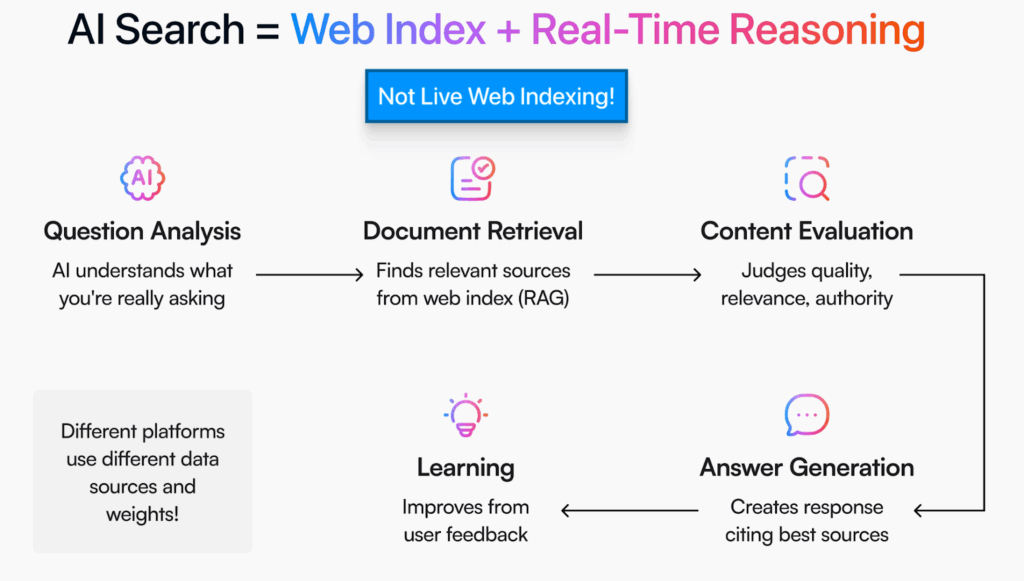Why Each AI Platform Shows Different Answers


When you ask the same question on ChatGPT, Gemini, or Perplexity, you’ll notice something surprising: the answers don’t just sound different, they’re often sourced from entirely different places.
That’s because each AI platform taps into a different index, like Google, Brave, OpenAI’s own, or even proprietary crawlers to retrieve information.
Visibility is fragmented. For marketers, this means: showing up in Google’s AI Overviews doesn’t guarantee you’ll appear in Perplexity, Claude, or Grok.
This blog breaks down how AI indices work, why results vary so much, and how Generative Engine Optimization (GEO) helps you stay visible no matter which AI platform your audience uses.
Key Takeaways
- Each AI platform uses a different index (Google, Brave, OpenAI’s own, or proprietary crawlers), so visibility is fragmented by design.
- Ranking on Google alone is no longer enough; your brand can appear in one AI engine and be completely absent in another.
- AI search = index + reasoning, understanding how indices work is key to influencing what AIs say about you.
- Writesonic helps track, benchmark, and optimize your brand’s presence across all major AI platforms.
Why AI Platforms Use a Different Index
AI platforms don’t share a universal source of truth.
That’s right.
Every time you ask a query, the AI tool doesn’t “browse the web live.” That’s because each AI platform relies on its own index (or a partner’s) to retrieve information.
- ChatGPT Free → OpenAI’s index
- ChatGPT Plus → Google’s index
- Claude → Brave’s index
- Gemini → Google’s index
- Perplexity & Grok → their own indices
This explains why when you ask “best generative engine optimization tools,” Gemini might cite one set of blogs, Perplexity another, and ChatGPT Free something else entirely.
In other words, there’s no single AI web. There are multiple fragmented realities, and your visibility depends entirely on which index a platform is tied to. For marketers, it creates a new visibility gap: showing up in one AI engine doesn’t guarantee you’ll exist in another.
How AI Search Really Works
The biggest misconception is that AI tools “search the live web.” They don’t.
Instead, they use a mix of web indices + real-time reasoning to generate answers. Here’s the breakdown:
1. Question Analysis: First, the AI interprets what you’re really asking. It’s not just keyword matching. Then it tries to capture the intent.
2. Document Retrieval: Next, it pulls from its chosen web index (Google, Brave, its own, etc.) using RAG (retrieval-augmented generation). This is where platform differences come: the index it leans on determines which sources even make it to the AI answer.
3. Content Evaluation: Then, the AI evaluates those retrieved documents, judging relevance, authority, and overall quality. Some platforms weigh news more heavily, others prefer evergreen content.
4. Answer Generation: Based on that filtered set of documents, the AI generates a response and often cites the sources it trusts most.
5. Learning Loop: Over time, user feedback (clicks, follow-ups, ratings) helps the AI refine future answers.

So when people assume “AI is searching the live web,” that’s not completely true.
It’s really “AI Search = Web Index + Real-Time Reasoning.”
And because every platform plugs into a different index, your brand’s visibility changes dramatically depending on where the question gets asked.
Why This Matters For Marketers
Rank in Google, win the clicks; this used to be the ultimate goal before, since there was just one system to optimize for.
However, not anymore. Today, visibility is fragmented, creating major challenges for marketers. Here are the top 3 challenges:
1. Missed Reach
Different platform pulls data from different indexes. That means if your audience is asking questions in Perplexity but you only optimize for Google, you’re invisible there.
Simply, ranking #1 in Google doesn’t guarantee inclusion in Perplexity or Grok. Every index has its own gates, biases, and priorities.
2. Inconsistent Brand Narrative
Different indices may surface different sources, which means the way your brand is described can vary wildly across platforms.
Your brand might be positioned as “best answer engine optimization tools” in one AI answer and an “average option” in another. Consistency—the thing SEO gave us, is gone.
3. High Volatility
Unlike SEO, where Google’s dominance gave us one clear understanding about what to do, AI is multi-engine by design.
Indices are changing fast. A platform might quietly rebalance how much weight it gives to news articles, forums, or product sites. Overnight, your visibility can spike or vanish.
What this really means is that AI has fractured digital visibility.
It’s no longer enough to ask: “How do I rank in Google?” Instead, the question becomes: “How do I show up across every AI search engine my audience uses?”
And that’s exactly where Generative Engine Optimization (GEO) comes in.
How Writesonic Can Help With GEO
Instead of guessing how AI platforms see your brand, Writesonic gives a single place to track, compare, and optimize visibility across engines like ChatGPT, Gemini, Claude, and Perplexity.
Here’s what it can help with:
- Track brand presence: See where your brand (and competitors) appear across AI platforms, along with sentiment and share of voice.
- AI traffic analytics: Reveal which AI crawlers are visiting my site, which pages they pull, and how often.
- Citations & insights: Check how AIs actually mention my brand in responses, which sources they cite, and get suggestions to improve coverage.
- Custom tracking: Monitor the topics, prompts, and competitors that matter most to me.
The best part? Writesonic turns all of this into an end-to-end workflow: track → compare → optimize → create → measure.
Instead of being invisible in half the AI search world, you can finally take control of how my brand shows up across engines.
To see Writesonic in action, get in touch with our team!
Frequently Asked Questions
1. Why don’t all AI platforms give the same answers?
Because they pull from different indices, Gemini uses Google’s, Claude leans on Brave’s, Perplexity crawls its own, and ChatGPT Free has OpenAI’s. Same question, different data → different answers.
2. If I already rank high on Google, do I still need GEO?
Yes. Google visibility doesn’t guarantee placement in Claude, Perplexity, or ChatGPT. GEO helps ensure you’re discoverable across all AI platforms, not just one.
3. Can I influence which sources AIs cite about my brand?
Indirectly, yes. By knowing which sites different indices rely on, you can create, update, or build relationships with those sources so they represent your brand accurately.










